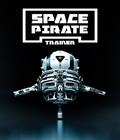Being a pirate is difficult: plundering, smuggling, and the constant threat of the law. What looks like a liberating lifestyle is hard work and demands intensive training, especially if you're a space pirate who slings laser weapons for a living.
Space Pirate Trainer is a weapon training exercise that lets you endure endless waves of faceless drones and robots in an attempt to chase the next high score. Originally released for VR on the PC, Space Pirate Trainer can be seen as one of the first solid wave shooters that made its way into VR, and many followed. Nowadays, PSVR has a slew of its own wave shooters. The recent release of Space Pirate Trainer on the PS4 can be easily dismissed as just another entry in the genre. While that is technically correct, the game succeeds in delivering a solid and fun experience.
Space Pirate Trainer scores with simplicity. There isn't a heavy story or lengthy tutorials to wade through. Once you put on the VR headset, you're in the middle of the action. We're positioned in what looks like a spaceship hangar, and immediately, we have the option to jump into a spaceship to try out one of several game modes. A little picture gallery to our right provides some tips and tricks, a leaderboard to our left lets us know just how well we fare globally based on game modes and weapon usage.
The main advantage of this setup is that the game is already loaded upon entry, and it stays this way. As soon as we start a game, the menus disappear, and the action begins. There are no loading screens to interrupt consecutive playthroughs.
The gameplay is similarly simple, but it can be rewarding and skillful if we make it so. We have a weapon in both hands, which are controlled by the PlayStation Move controllers, and we fend off increasingly difficult waves of drone enemies. We're stationary, so movements are restricted to our headset and the controllers (a boon if you're prone to motion sickness). However, surviving the growing onslaught of laser- and rocket-firing drones requires us to be on our toes and constantly move both our upper body and hands.
Generally, Space Pirate Trainer works the same way in every playthrough. Our trusty blasters are used to destroy whatever comes in our way. We can switch the blasters between several firing modes, such as ion grenade, pulse blaster, rail gun, shotgun and more. This provides ample opportunity to try out different styles. When players jump into the game without specifically selecting a firing mode, the pulse blaster is chosen by default. The blaster's powerful but slow-moving shots add a layer of anticipating enemy movement and getting the trajectory of our shots just right. Moving on to other firing modes, we may sacrifice damage for widespread range with the shotgun or accuracy when slinging grenades at enemies. We can also use different weapons/firing modes on each hand to maximize our possible combat opportunities.
On the other hand, our enemies have a relatively straight shot, but that doesn't mean we're a sitting duck in an endless laser onslaught. As previously mentioned, movement is key. As soon as bullets get close, the game automatically enters slow motion (except when playing in hardcore mode) to enable us to dodge incoming fire, which is a satisfying game mechanic that almost feels as great as dodging bullets in SuperHot. The game can occasionally feel like a stressful yoga simulator as you try to dodge incoming damage and fire at insane angles in the hopes of surviving another wave.
While your blasters may be your go-to choice in weaponry, both of our hands have an alternative option. Grabbing behind your shoulders gives you access to either a shield or a futuristic saber. While the use of the shield is self-explanatory (except for its shockwave function), the saber is where the gameplay gets even more interesting.
While it does the obvious — slicing drones in half — it's much more versatile. Incoming lasers can be deflected, similar to a lightsaber, and a special laser can be used to grab and pull enemies toward you. The same long-range laser can also be used to activate two kinds of turrets to your left. As long as we maintain a connection between the saber and the turret, they either fire or emit shockwaves at everything that moves.
This creates an interesting risk-reward gameplay loop, as juggling all the different attack and defense options provides room for experimentation and finding your own style. Using the turrets can work beautifully against stronger enemies, while maintaining a constant connection with one arm to the turret can leave you equally vulnerable and sacrifice firepower.
Shooting drones out of the sky occasionally drops item crates that grant temporary buffs such as a black hole, faster bullets, higher fire rate, homing missiles, or surrounding shields. The goodies come in handy, but they're not dropped so often that they water down the experience. At its core, Space Pirate Trainer combines a slate of good ideas into a solid and satisfying package that is easy to get into while also providing enough layers to make it interesting to try out different play styles. This is reflected in the score system, which has separate leaderboards for every weapon/gameplay style.
When moving away from the general gameplay style, Space Pirate Trainer becomes more traditional. It's a wave shooter and doesn't deviate from that formula. Classic mode grants us three lives to go through all of its waves, Explorer mode reduces the score by 50 percent but replenishes lives along the way, and Hardcore mode removes the slow-motion bullet time.
The enemy design is solid, but it can appear a bit unimaginative in places. The game makes you sweat quickly with a variety of enemies that all behave differently in their attack rates, health, movement and types, but at the end of the day, they're mostly close variations of each other to a certain degree. Ultimately, there's a chance that the visuals may feel boring.
It won't be easy to clear the waves. While the game provides assistance for the early wave stages by offering checkpoints in 5- to 10-wave intervals so you can jump in without having to restart from the beginning. There seems to be no upper limit in terms of waves; it feels hard to impossible to get far enough into the game where this could become a concern. It's challenging in a positive way, and there's always more metal to shoot of the sky.
Space Pirate Trainer benefits from all of the years it's been out on the PC. The tracking is usually the main complaint on PSVR, but it's mostly spot-on and has very few glitches, so the game is very satisfying to play. If you lose, it's likely you weren't quick or skillful enough rather than due to a tracking mishap. The same goes for its visuals, which are toned down but still reasonably sharp and fluid.
One also can't overstate Space Pirate Trainer's pick-up-and-play value and its satisfying shooting gameplay and rumble feedback. The party mode to facilitate a face-off against friends and family does the rest. It's not a masterpiece, but it's a small and satisfying experience that is highly appreciated. The only real complaint is the content, which isn't a major issue given the solid gameplay and the comparably low $15 price tag.
In the end, Space Pirate Trainer may have come a little too late to PSVR. While the platform has a larger install base, the genre has already seen countless entries. Space Pirate Trainer was one of the first and is probably the best and easiest way to get going with VR in a small and satisfying package that works remarkably well. If you get easily hooked on simple-to-learn and tough-to-master high-score games, this is an easy recommendation.
Score: 8.0/10
More articles about Space Pirate Trainer











 Space Pirate Trainer is the official trainer for wannabe space pirates in VR. Pick up your blasters, put on your sneakers, and dance your way into the Space Pirate Trainer hall of fame.
Space Pirate Trainer is the official trainer for wannabe space pirates in VR. Pick up your blasters, put on your sneakers, and dance your way into the Space Pirate Trainer hall of fame. 

















